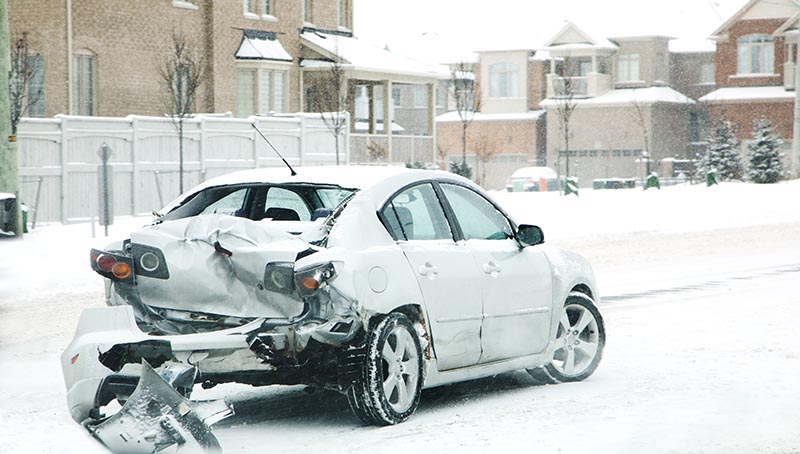10 Car Accident Statistics and Facts in Canada: Updated in 2025
-
Codee Chessher
- Last updated:

Note: This article’s statistics come from third-party sources and do not represent the opinions of this website.
The World Health Organization estimates that car accidents kill an average of 1.3 million people worldwide annually, which makes them a very serious topic to look into. As the west is transitioning into an age of EVs, it’s still important to keep an eye on the key causes of car accidents to help prevent future deaths in Canada and the U.S.
Let’s check out some of the most eye-opening stats and facts about the impact of car accidents in Canada down below.
Click below to jump ahead:
- Car Accident Fatality Statistics in Canada
- Causes of Car Accidents in Canada
- Canada Driving Safety Statistics
The 10 Car Accident Statistics in Canada
- The 25-year-old to 34-year-old demographic had the most injuries from car accidents in Canada in 2019.
- 40% of speeding drivers in Canada are aged between 16 to 25 years old.
- More than 330 pedestrians were killed during road traffic collisions in Canada in 2018.
- Canada has an estimated 2,800–2,900 deaths from more than 160,000 road collisions per year.
- 27% of Canadian road fatalities were directly caused by speeding.
- Drunk drivers in Canada are 51 times more likely to be involved in a fatal car crash.
- In 2020 alone, heavy snow was present in almost 1,500 accidents, light snow was present in more than 900 collisions, and hail or sleet was a factor in over 175 crashes.
- Wildlife contributed to over 45,000 non-fatal car accidents in 2020.
- 95% of all Canadian adults surveyed claim to always wear their seat belts.
- Distracted driving increases the chances of a car accident by roughly 500%.

Car Accident Fatality Statistics in Canada
1. The 25-year-old to 34-year-old demographic had the most injuries from car accidents in Canada in 2019
(Statista)
It’s a bit surprising to find that this middling age group has the most injuries among Canadians, but it makes sense when you realize it’s injuries and not deaths. It’s possible that the right way to look at this statistic is that injuries are far preferable to deaths. We speculate that drivers out of their teens have matured enough to at least wear their seat belts, although drunk driving is always a concern.

2. 40% of speeding drivers in Canada are aged between 16 to 25 years old
(Canada Association of Chiefs of Police)
This stat surprises absolutely nobody out there. There are several compelling reasons that young people have fewer accidents: less experience behind the wheel, more likely to engage in risky behavior, and a higher likelihood of speeding and driving while intoxicated.
3. More than 330 pedestrians were killed during road traffic collisions in Canada in 2018
(Statista)
Pedestrian deaths during road traffic collisions is a fancy way of saying a car ended up hitting a person for one reason or another. There are actually numerous reasons this happens: pedestrians and drivers not being observant enough, speeding drivers who have less margin of error, drunk drivers with sluggish reflexes, poor visibility caused by weather, and more. More widespread adoption of public transportation is likely to see this number decrease in the future.

4. Canada has an estimated 2,800–2,900 deaths from more than 160,000 road collisions per year
(Government of Canada National Transportation Safety Board)
This number is dropping every year in Canada, unlike the U.S. It’s difficult to explain this at a glance, but there’s a lot at work. Canadians prefer smaller cars than Americans, which usually fare better in a car accident than an SUV or truck. Canada also taxes gas at a higher rate than the U.S., discouraging frivolous travel and speeding. Last but not least, Canadians are far more likely to use public transportation than Americans, further improving safety and reducing road collision fatalities.
 Causes of Car Accidents in Canada
Causes of Car Accidents in Canada
5. 27% of Canadian road fatalities were directly caused by speeding
(Carsurance)
This is actually slightly higher than the U.S., which estimates 25% of American road collision fatalities were the direct result of speeding. Data has shown that younger drivers and especially teenagers are more likely to speed and engage in other risky driving behavior, like drunk driving. Regardless of your age and inebriation level, though, speeding means you have less time to react to unexpected events that happen on the road. In some instances, that sliver of time can make all the difference, and speeding further sharpens that sliver to a deadly edge.

6. Drunk drivers in Canada are 51 times more likely to be involved in a fatal car crash
(MADD Canada)
Mothers Against Drunk Driving are a nonprofit primarily devoted to reducing drunk and intoxicated driving deaths. They’re somewhat notorious for their teetotaler stance on intoxicants – “No alcohol. No drugs. No deaths.” The statistic itself isn’t a shocker to anyone, considering how badly alcohol impairs your cognitive and motor functions. The likelihood of an accident rises exponentially with a higher blood alcohol content (BAC); it rises after just one or two drinks and skyrockets at a BAC of 0.05, which is typically considered drunk. From 0.05 to 0.10, it gets even worse.
7. In 2020 alone, heavy snow was present in almost 1,500 accidents, light snow was present in more than 900 collisions, and hail or sleet was a factor in over 175 crashes
(Greg Monforton and Partners)
Inclement weather is a significant obstacle that we can never really get rid of, only mitigate to the best of our ability. Heavy snow can prevent drivers from going anywhere at all, and those who do drive are putting themselves and others at grave risk. If you have to drive in poor visibility conditions like snow, try to drive more slowly and make sure your car is properly winterized. If possible, don’t go out at all when it’s hailing out to prevent damage to your car.

8. Wildlife contributed to over 45,000 non-fatal car accidents in 2020
(Tests.ca)
Canada is full of wildlife so it is no surprise that animals caused over 45,000 non-fatal collisions in 2020. While there are signs that indicate the driver is in an area where there are deer, moose, and other animals close to the road, a driver can never fully predict when one of them will cross the road.
Canada Driving Safety Statistics
9. 95% of all Canadian adults surveyed claim to always wear their seat belts
(TransportCanada)
These stats are difficult to accurately gauge because it relies on surveys that people can lie on, but public safety awareness has significantly increased seat belt usage worldwide. Wearing a seat belt in a moving vehicle is essential because it negates the risk of being fatally ejected from the vehicle. Even so, reckless and drunk driving can still cause injuries and death for those wearing seat belts—it’s simply less likely.

10. Distracted driving increases the chances of a car accident by roughly 500%
(Carsurance)
As smartphones and more fancy infotainment systems become ubiquitous, distracted driving becomes more prevalent. The U.N. estimates this contributes to 1.3 million car accidents per year, which is a huge deal. Other stats speculate that driving while using your phone can be up to 6 times more likely to cause an accident than drunk driving. Just like any reasonable, sane person wouldn’t drive drunk, you shouldn’t text and drive, either.
Frequently Asked Questions About Car Accidents in Canada

What are the top causes of car accidents in Canada?
Respectively, the leading causes of road collisions in Canada are speeding, intoxicated driving, and distracted driving. Distracted driving includes texting and driving as well as doing anything else in the vehicle to take your eyes and attention off the car and roadway.
Despite the alarming stats above and rising car accidents in the U.S., Canada, and European countries have seen a notable decrease in car accidents over the past decade or so. Relevant factors include better safety awareness, more robust and durable vehicles, Canadian car preferences, and more.
What should I do after a car accident in Canada?
First, check to ensure everyone in the car is okay before calling medical services and law enforcement. They’ll provide medical assistance and document the incident, respectively. Providing proof of what happened is helpful, like dash cam footage. You must try to recollect the events leading up to and including the collision when you’re interviewed by law enforcement.
Do I need to hire a lawyer after a car accident in Canada?
Maybe. There is a confluence of variables that determine whether you need a lawyer, but the best way to handle it is to take advantage of free consultations. Attorneys can look at your situation and advise whether it would be prudent to retain legal counsel. It’s especially important to get a lawyer if you’re at fault for the accident because there may be legal, medical, and financial consequences.
Conclusion
Car accidents are a traumatic experience even if you get out of one unscathed. Canada is keeping up with Europe as far as decreasing road collisions, but still has a ways to go if it wants to eliminate the bulk of car accident fatalities.
Featured Image Credit: Daniel Avram, Shutterstock
Contents

 Causes of Car Accidents in Canada
Causes of Car Accidents in Canada